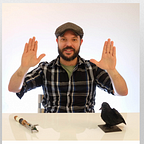How to Use QA to Debug Your Life
Quidd’s Charlie Irwin, a member of our Quality Assurance team, reviews Quidd updates in order to find what’s broken and insures these bugs are fixed –– we never want an update to break things in some unforeseen way. We heard Charlie had a theory on using this magical QA process on real every day situations and we asked him to share his wisdom with the world. Here’s how to use simple QA steps to debug your daily life…
I am by no means a philosopher or self helper but after working in QA for a while, I’ve noticed how the methodology of searching for and reporting software issues can be applied to my personal/emotional life. The break-down is pretty simple and it has helped me a lot in navigating tough personal situations. Maybe it will help you too!
Let’s say you are in a relationship, and you keep running into the same issues over and over again with your spouse. These negative patterns happen in all relationships and I think we humans tend to get wrapped up in the emotion of it all. Rather than dealing with these patterns objectively, we end up resentful and frustrated. So. When a personal situation or pattern starts to twist your brain around, sit down and try the following:
1. Make a summary
What exactly is the issue that’s arising — or what’s happening that’s causing an undesired outcome?
2. Define preconditions
Where are/were you? What are/were you doing? Hungry? Tired?
Also feel free to include general truths about your history and present life or future goals. Try your best to be totally self aware when analyzing these preconditions.
3. Define the steps to reproduce
You can define these steps by asking, “What did I/we do specifically to expose this issue?” Backtrack a few hours, or to the beginning of a conversation and break it down into simple clear steps. What did “A” do? How did “B” respond? I recommend 5 to 10 steps. That’s what works best for me.
4. State the actual/current result
This is in a way re-stating the summary, but perhaps in researching the steps, the result has been somewhat re-defined. Perhaps another separate but related issue has been revealed, or another issue that is blocking you from getting to the real cause of this one.
5. State the expected/desired result
Without any anger or resentment, define your ideal result. How SHOULD things work? What is the desired outcome?
I’ve found that thinking about things this way gives me a fresh, honest perspective as to my own bugs/issues and can help me better communicate them. Then, my inner Dev can get to work.
Some final advice:
Be patient with yourself. We are all always in progress. Just be sure you review your code to the best of your ability before the next deploy.
Be thoughtful and spread the love.
-Charlie
